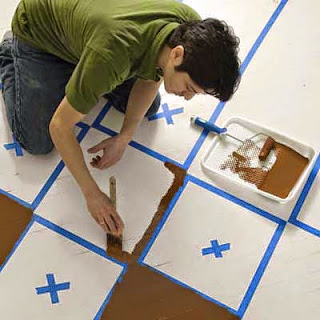I personally LOVE painted wood floors. I am a very traditionalist at heart and even though my tastes have stepped up to the present... my heart will skip a beat when I see a painted foyer/entry floor. What better way to welcome everyone to your home than to have a first impression that says "I really do care about the details of my home."
Although it’s relatively uncommon to see painted wood floors today (however... they seem to be making their way back into the limelight), as clear-coated hardwood has become the preferred option for most homeowners, they were once a staple of interior design. From decorative patterns, some of which mimicked parquetry, to monochromatic schemes, painted wood floors were in widespread use in American homes by the late 1700s. Popular colors included white, yellow, red, and green. But it wasn’t just about aesthetics—paint also helped protect the wide-plank pine floors of the time.
Check out this great step by step instructional! |
 |
| 1. Prep the Base |
To
make the paint adhere better and the finish last longer, sand and clean the
floor first. Coating the entire floor using the lighter of the two colors as a
base coat creates a clean slate for laying out the pattern and acts as a primer
for the darker pattern color.
Using
a sanding sponge, gently rough up the floor finish and level any high spots
from previous stain or filler. Wipe the floor clean with a damp sponge and
allow it to dry thoroughly. Cover the space beneath doors with plastic to
prevent dust from blowing in and ruining the wet finish.
2. Paint the Base Coat
Paint the base color around the edges of the floor with a 2½-inch paintbrush. Using a paint roller, coat the entire field, starting opposite one door so that you paint yourself out of the room. Let the paint dry completely. If necessary, lightly sand the floor and apply a second coat. Let the paint dry overnight before laying out the pattern and applying the second color.
3. Measure and Mark the Pattern
Setting
a checker pattern on a diagonal looks dynamic and makes the room appear bigger.
But the pattern will look best if it ends in perfect half-square triangles at
the most visible walls. So figure out which wall is least visible and start
measuring on the opposite side of the room. Keep in mind that the painter's
tape outlines the box you're painting, so it will fall on alternating sides of
the pattern's lines from square to square.
Estimate
the number of squares you want to fit across the center wall of the three most
visible walls. Divide the length of the wall by the number of squares. With
this measurement, mark the wall from corner to corner.
4. Make the First
Square
Find
the center point between the first two marks and note the distance from the
corner to the center. Using a framing square, draw a perpendicular reference
line out from the point, making it the same length as the distance from the
corner to the center point. Then connect the corner to the end of the reference
line. This is the side of the first square.
5. Complete the Pattern
Using
a straightedge, extend the line out into the room. Mark the entire line at intervals
to match the length of the side of each pattern square. Using a framing square
as a right-angle guide, complete the squares at each mark. Double-check your
layout by making sure you connect back to the marks on the first wall.
6. Mask the Squares
With
all the squares drawn, use painter's tape to X out the squares you don't intend
to paint. Then tape around the outside edges of the unmarked
squares.
7. Cut the Tape with a Putty Knife
Cut
each piece of tape perfectly by tearing it against a putty knife: Hold the
blade on the tape and rip away from the knife to execute a perfect cut and make
sharp corners for each square.
8. Complete the Tape Outline
Seal
the tape to the floor by pulling the putty-knife blade over the tape to remove
air bubbles and prevent paint from bleeding underneath and onto the
lighter-colored squares. Continue taping until all the unmarked squares are
outlined.
Tip: Clean up pencil marks with a damp sponge
instead of an eraser, which could damage the freshly painted base coat.
9. Paint the Pattern
The
tape around each square is an excellent guide for painting, but an uneven wood
floor is a difficult surface on which to tape. So to help keep paint from
bleeding under the tape, cut in the edges of each square with a brush. You can
speed up the finish with a mini roller.
Using
a sanding sponge, lightly sand the squares to be painted and wipe them clean.
Using a 2½-inch paintbrush, apply paint around the edge of the square. Start
each stroke on the tape and pull it into the square so that the color doesn't
push under the edge. Coat the entire perimeter of the square this way. While
the edges are still wet, fill in the field using a mini roller. Roll the paint
on in the same direction as the floorboards. Continue painting the squares in
this manner until the floor is finished. Clean up any drips or mistakes by
wiping them up with a damp rag while they're still wet.
10. Remove the Tape
Remove the tape before the paint dries so that it doesn't
pull up any color with it. Peel the tape up and away from the paint at an angle
to leave a clean edge.
11. Finish Coat the Floor
Porch
and floor paint is very durable, but for high-traffic areas consider topping
the floor with a coat of polyurethane. After the paint has dried for a
full day, use a roller to apply the finish evenly across the floor. If you plan
to add a second coat of paint, lightly sand the first coat before putting the
second one down.
Tip: The higher the gloss on paint or
polyurethane, the more durable it is. If you want the resilience of high gloss
without the shine, put on a top coat of satin polyurethane to tone down the
gloss.
I love painted floors. Would you like to see a little more inspiration? - here's a little something for everyone.




























